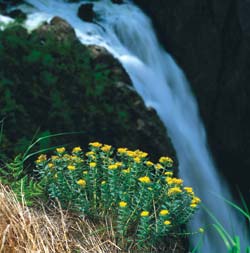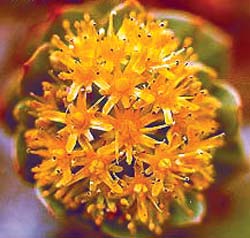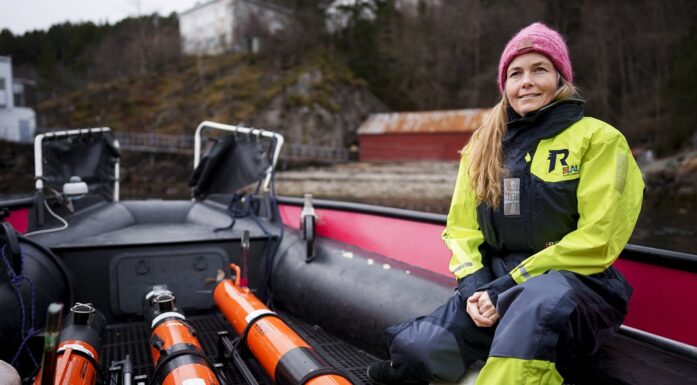The healing powers of roseroot
A magic plant called roseroot grows wild in Norway. Roseroot helps improve memory and the immune system and stabilizes cholesterol levels, blood pressure and blood sugar levels.
It may not be necessary to travel to faraway, exotic places to find herbs or plants with medicinal qualities, like ginseng. Norway has its own version – roseroot – and researchers are actively investigating the properties of this common, but little-known plant. Roseroot has been used in folk medicine for more than 3000 years, and grows throughout Norway, from Agder in the very south, up to Bjørnøya in the Svalbard archipelago.
NTNU’s Plant Biocentre in the Department of Biology has analysed the plant’s essential oils and volatile compounds. A test of the plant’s cancer prevention properties is also planned. The Norwegian Crop Research Institute, Planteforsk, is working on cultivating the plant, while Norwegian companies are trying to develop new dietary supplements containing roseroot. Success could mean new jobs in both agriculture and industry.
A natural Viagra?
The list of roseroot’s beneficial qualities is long: it is thought to improve memory and help with the way the body manages stress. Some of its compounds benefit the heart by reducing the levels of stress hormones in the blood. Roseroot may also stabilize blood pressure, as well as blood sugar and cholesterol levels. It is also thought to be a strong antioxidant that might act to prevent cancer. Last but not least, roseroot appears to be a libido booster – a kind of natural Viagra – that works for both men and women.
With such a stellar list of properties, roseroot looks to challenge ginseng on the world market as a health product and dietary supplement, especially since roseroot appears to have no unwanted side-effects. Ginseng, in contrast, may cause constipation or nausea. And roseroot ranks far higher than ginseng when evaluated as a plant with adaptogen effects, or a plant that responds to the body’s needs. Only eleven such plant species are known from around the world, and only roseroot and two others – schizandra and Russian root – exhibit all the characteristics that define adaptogens.
Ancient folk remedy
Roseroot has been used for more than 3000 years as a folk remedy, and recent research in a number of countries has confirmed many of the plant’s medical benefits, according to Professor Steinar Dragland of Kise, a division of Planteforsk.
Russians have studied the plant for decades and have used roseroot for their athletes and astronauts. In 2002, the plant was tried in a clinical test in the United States.
CANCER PREVENTION
Early in 2004 botanists and cancer researchers at NTNU will join forces to test the effect of extracts of roseroot on certain types of cancer.
Photo: Jens Rohloff
Roseroot and cancer
Planteforsk has roseroot samples from nearly 100 locations in Norway. These are being examined to decide which plants might be the best for commercial development.
The Plant Biocentre at NTNU is also trying to unravel the mysteries of the plant’s compounds. Scientist Jens Rohloff recently completed his doctorate on medicinal plants and herbs in Norway. He identified 90 aromatic compounds in roseroot – including the one responsible for the characteristic rose scent that is emitted from the roots. Early in 2004, botanists and cancer researchers at NTNU will collaborate to test the effect of roseroot extracts on certain types of cancer.
Roseroot for sale
Rosenrot.no, a company in Gran in the county of Nord-Trøndelag, has received government funding to cultivate roseroot and manufacture roseroot products. Steinar Storøy, who heads the project, says that two masters students from the Nord-Trøndelag University College have already developed the first roseroot products intended for the health food market. Roseroot has not yet been approved for commercial distribution, but approval by the Norwegian Medicines Agency is expected in the near future.
Planteforsk has been contacted by American businesses that want access to Norwegian raw materials. Dragland says the companies were turned away because of concern about overharvesting of wild roseroot. Before production can expand, Norwegian farmers must begin its commercial production at levels sufficient to provide stable, long-term access to raw materials. But many of the details of roseroot’s production and cultivation are still being researched.
By Nina E. Tveter
FACTS
- In the wild, the roseroot (Rhodiola rosea) is approx. 30 cm tall
- Extracts are made from rhizomes and roots.
- Active ingredients are slidroside, rosavin, rosarin, and rosin.
- Dietary supplements from roseroot will likely be approved in the near future in Norway.







